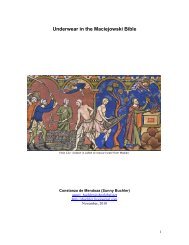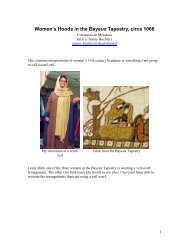Burgundian Noblemen's Underclothes c1445-1475
Burgundian Noblemen's Underclothes c1445-1475
Burgundian Noblemen's Underclothes c1445-1475
Create successful ePaper yourself
Turn your PDF publications into a flip-book with our unique Google optimized e-Paper software.
5. What is the shape of the codpiece?<br />
6. What is the shape of the feet?<br />
7. Where are the seams and how are the hose constructed?<br />
I’ll take each of these in order:<br />
1. Are the legs separate or sewn together across the butt?<br />
Figures 5-9 obviously have one leg separate from the other (they can be removed<br />
separately or rolled down. However figures 10-12 are just as obviously joined hose<br />
(separate legs would fall down like in Figure 7 if the center back point was released).<br />
Since figures 7 and 10 come from the same painting, I conclude that this time period was<br />
a transition era between the styles and both could be found. I hypothesize that earlier in<br />
this era the split hose were more common and later the joined hose were more common.<br />
My reasoning is due to joined hose being predominate at the turn of the 16 th century, and<br />
that there was an impetus towards the hose covering the butt due to the rise in the<br />
hemline of the over-gown from mid-thigh to mid-butt between 1445 and <strong>1475</strong>. If you<br />
choose to do split hose, be aware that the underwear will show occasionally, as in this<br />
Italian picture:<br />
Figure 6.16<br />
1452-66 Piero della Francesca, Battle<br />
between Heraclius and Chosroes (detail)<br />
2. Do the hose have attached feet?<br />
Hose are worn with shoes in the majority of the pictures showing feet, making this<br />
question difficult to be sure of the answer. I have found no pictures that show hose being<br />
cut off at the ankle (although there are some in Italian art). Figure 12 shows a stirrup<br />
rather then a full foot. If shoes are not worn over the hosen, then almost always the hose<br />
have feet attached, as in Figure 5, 13, 14 & 15. There are a number of fragments of extant<br />
hose (although I know of none from this period for northern Europe); most of the extant<br />
pieces have feet (or the remains thereof). See Marc Carlton’s website for a summary:<br />
18






